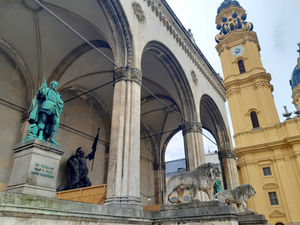
Ana, Felix, Nikolaj, and Yinon
Exploring History through Monuments
Source: Kim Wünschmann
Pantheonization in Munich and Jerusalem
Join the exchange student Ana as she goes on an exploration of pantheonization of Germany history in Munich and Jerusalem. To understand a foreign nation, its historical narratives, myths, and legends, it is worth studying sites that honor distinguished national figures and commemorate the fallen of past wars. Pantheonization plays an important role in efforts of nation-building. In the case of Germany, it is a particularly interesting phenomenon given the country’s relatively late unification in 1871 and the strong regional identities of the German States that live on until this day—especially in the Free State of Bavaria.
New to Munich, Ana sets out on a discovery of the city’s most famous monuments and sites of pantheonization. On her journey, she encounters three fellow students—Felix, Nikolaj, and Yinon—who assist her to uncover a complex history of commemoration manifest in four key places: the Kriegerdenkmal (Warrior Memorial) in Munich’s Hofgarten, the Feldherrnhalle (Field Marshals’ Hall) at the Odeonsplatz in the city center, and the Ruhmeshalle (Hall of Fame) built around the Bavaria Statue that overlooks the Theresienwiese, famously known as the site of Munich’s annual Oktoberfest. Finally, Ana’s trip even leads her to Jerusalem where she finds a most unexpected war memorial at the German Templer cemetery which is located in the neighbourhood of HaMoshava HaGermanit (the German Colony).
Sharing a profound scholarly interest in pantheonization, we created a podcast that presents our joint research as the story of Ana’s journey through Munich and Jerusalem. And, just in case you are curious: Ana is indeed an exchange student at LMU Munich.
Group Members
Yinon Guttel-Klein, Anastasia Hansch,
Felix Kretsch, and Nikolaj Kunkel
Producer: Jaya Mirani
Speakers
in order of appearance
Ana – Anastasia
Nikolaj – Nikolaj
Felix – Felix
Yinon – Avraham
Sources
Kriegerdenkmal
Chornyi, Maksym (2019). “War Memorial in Munich.” War-Documentary Blog.
Weiß, Dieter J. (2005), “Rupprecht.” In: Neue Deutsche Biographie 22, 285–286.
Bavaria Statue and Hall of Fame
Fischer, Manfred (1972). Bavaria und Ruhmeshalle: Amtlicher Führer. Munich: Bayerische Verwaltung der Staatlichen Schlösser und Seen.
Rattelmüller, Paul (1977). Die Bavaria: Geschichte eines Symbols. Munich: Hugendubel.
Schaaf, Christian (2001). Die Ruhmeshalle und die Bavaria in München als partikularstaatliches Nationaldenkmal. Munich: GRIN Verlag.
Feldherrnhalle: Infos und Geschichte zum Wahrzeichen am Odeonsplatz. München.de: Das offizielle Stadtportal.
Lieu de Mémoire and Field Marshals’ Hall
Mai, Gunther (2018). Die Weimarer Republik. Third, revised edition. Munich: C.H. Beck.
Konczal, Kornelia (2013). “Erinnerungsorte: Über die Karriere eines folgenreichen Konzepts.” In: Hahn, Hans-Henning and Traba, Robert (eds.). Deutsch-Polnische Erinnerungsorte. Vol. 4: Reflexionen, Paderborn: Schöningh, 79–106.
Templer Cemetery in Jerusalem
Interview with Meir (Miro) Ahroni / מאיר (מירו) אהרוני conducted by Yinon Guttel-Klein on 15 December 2020.
Online search engine to find graves at the Jerusalem Templer cemetery,
Hasson, Nir (2011). “The fight against the memorial for Nazi soldiers in the heart of Jerusalem” [Hebrew].
Martin, Patrick (2011). “A hidden secret in Jerusalem’s German Colony.” The Globe and Mail.
Berg, Rafi (2013). “The Templers: German settlers who left their mark on Palestine.” BBC News, Jerusalem.
Further Reading on Pantheonization
Ben-Amos, Avner (2000). Funerals, politics, and memory in modern France, 1789–1996. Oxford: Oxford University Press.
Wrigley, Richard and Craske, Matthew (eds.) (2017). Pantheons: transformations of a monumental idea. London: Routledge.










